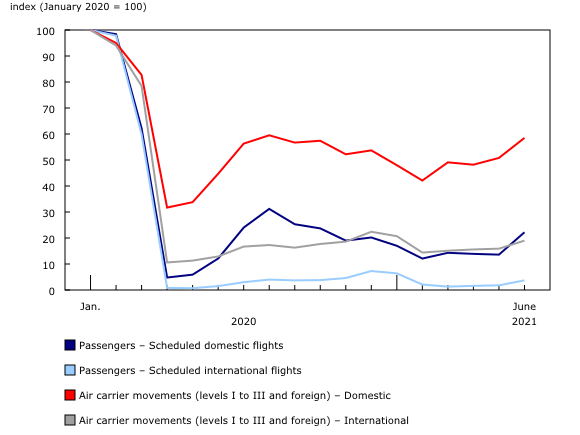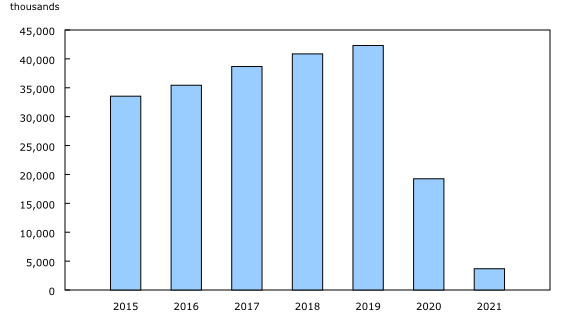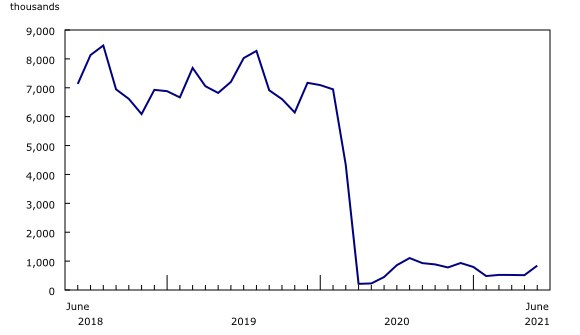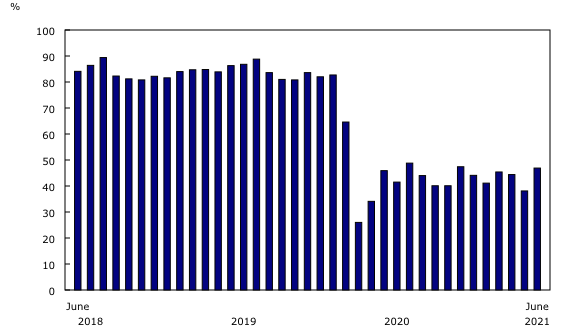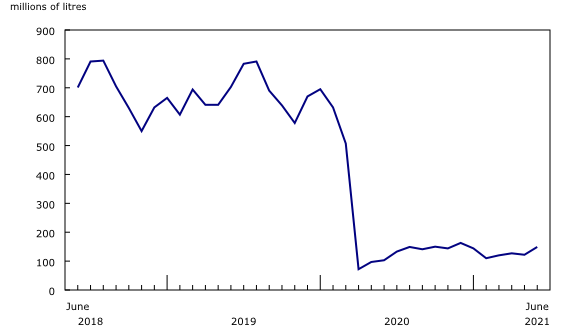Monthly civil aviation statistics, June 2021
Archived Content
Information identified as archived is provided for reference, research or recordkeeping purposes. It is not subject to the Government of Canada Web Standards and has not been altered or updated since it was archived. Please "contact us" to request a format other than those available.
Released: 2021-08-26
Highlights
Major Canadian airlines carried 844,000 passengers on scheduled and charter services during the month of June. While this was almost double the number of passengers from June 2020, it was down 88.3% from the pre-pandemic level in June 2019.
In June, passenger-kilometres and available seat-kilometres were 91.7% and 84.8% below their pre-pandemic levels, respectively, and the passenger load factor stood at 46.9%.
Compared with June 2019, operating revenues were down 83.8% to $367.0 million in June 2021.
Hopes pinned on the future
The number of new COVID-19 cases was on the decline in June, vaccination rates were on the rise, and many provinces began to gradually reopen after lockdowns in the third wave. Some interprovincial travel became possible again, and air carriers began reinstating some previously suspended routes.
However, all international travel restrictions remained in place throughout June. Border measures did not begin easing until July 5, when fully vaccinated Canadians and permanent residents of Canada were no longer required to quarantine or stay in a government-authorized hotel upon arrival by air in Canada. Since August 9, 2021, American citizens and permanent residents of the United States—who currently reside in the United States and meet specific criteria to qualify as fully vaccinated—have been allowed to enter Canada for discretionary travel.
On March 11, 2020, COVID-19 was declared a pandemic by the World Health Organization, and in the months that followed, Canadian air travel remained well below historical levels. Unless otherwise specified, comparisons in this release will be made with the same month of 2019 (also referred to as "pre-pandemic"), when airline activity levels were in line with historical trends.
An uptick in air travel
Canadian Level I air carriers flew 844,000 passengers on scheduled and charter services in June, the highest number since December 2020. This was down 88.3% from the pre-pandemic level of June 2019, but an improvement over the 92.5% decline in May (from May 2019, before the pandemic).
On a monthly basis, the number of passengers flown in June increased 64.2% from May, with increases recorded on both domestic and international flights. This increase may signal a turning point for the industry, as the five-year pre-pandemic average increase from May into the first month of the busy travel season was roughly 6%.
At 1.7 billion passenger-kilometres, traffic in June was 91.7% below the pre-pandemic levels posted in June 2019, while capacity was 3.6 billion available seat-kilometres, down 84.8% from two years earlier.
The passenger load factor, or the ratio of passenger-kilometres to available seat-kilometres, was 46.9%, the highest since December 2020, but down sharply from 86.3% in June 2019.
Other measures remain far below pre-pandemic levels
Despite an uptick in travel, each passenger travelled an average of 1,990 kilometres in June, 827 fewer kilometres than in June 2019, as international traffic remained low.
At 32,000, the number of flying hours in June was 83.0% below the pre-pandemic level posted in June 2019.
Operating revenue earned by Level I carriers totalled $367.0 million in June, down 83.8% from $2.3 billion reported in June 2019.
Depressing first half of the year
Data from the first half of 2021 reflect the continuing impact of the pandemic on air travel. While 2020 began with higher levels before dropping in March, airline activity in 2021 remained at historical lows throughout the first six months.
Canadian Level I air carriers flew 3.7 million passengers in the first six months of 2021, down 80.9% from the same period of 2020, and just a fraction of pre-pandemic levels for the same period.
At 7.4 billion passenger-kilometres, traffic in the January-to-June 2021 period was down 84.6% from the same months in 2020, while capacity declined 73.8% to 17.1 billion available seat-kilometres. The overall passenger load factor for the period was 43.6%, down from 74.3% in the same half of 2020.
Major airlines flew 152,000 hours in the first half of 2021, a 73.8% decline from the same period in 2020, and earned $1.9 billion in operating revenues, down 68.7%.
Note to readers
The Monthly Civil Aviation Survey covers all Canadian Level I air carriers: Air Canada (including Air Canada Rouge), Air Transat, Jazz, Porter, Sunwing, and WestJet (including Swoop, WestJet Encore and WestJet Link).
The average passenger trip length is calculated by dividing the number of passenger-kilometres by the number of passengers. Trips across Canada and the world are included in this calculation.
The data in this monthly release are not seasonally adjusted.
Data for the previous two months have been revised.
Contact information
For more information, or to enquire about the concepts, methods or data quality of this release, contact us (toll-free 1-800-263-1136; 514-283-8300; STATCAN.infostats-infostats.STATCAN@canada.ca) or Media Relations (613-951-4636; STATCAN.mediahotline-ligneinfomedias.STATCAN@canada.ca).
- Date modified:



